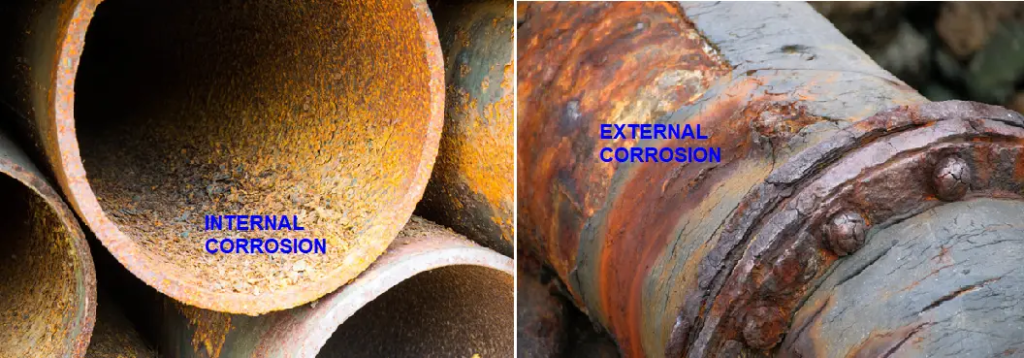In the piping industry, corrosion allowance plays a vital role in safeguarding pipes and equipment from the effects of corrosion. It points to the extra thickness incorporated into the design of pipes and other components to account for the expected corrosion during their service life. Corrosion is a natural process that takes place when metals are exposed to corrosive substances like water, acids, and chemicals. Over time, this can lead to the deterioration and weakening of the metal, posing risks such as leaks, equipment failures, and potential safety hazards.
To mitigate the potential failures caused by corrosion, piping systems are carefully designed with a corrosion allowance. This involves adding a small additional thickness to the pipe wall. The determination of this allowance considers various factors, including the anticipated corrosion rate of the material in the specific service environment and the intended service life of the piping system. By incorporating this method, engineers ensure that even if corrosion occurs, the pipe retains sufficient wall thickness to uphold its strength, integrity, and expected service life.
This allowance is typically specified by the piping design engineer based on industry standards and codes, specifically within the designated piping material class. It is a crucial parameter that contributes to the reliability and safety of piping systems. By accounting for the potential effects of corrosion, this allowance provides an extra layer of protection, maintaining the structural integrity of the pipes and preventing premature failures.
Factors Affecting Corrosion Allowance
The determination of this allowance in piping systems takes into account several key factors. These factors include the material used, the service environment, operating temperature and pressure, flow rate and velocity, and the expected service life of the system.
- The choice of material for the piping system, whether it’s carbon steel, stainless steel, or other alloys, can influence the corrosion rate and, consequently, the required allowance.
- The corrosiveness of the service environment, such as exposure to saltwater, acids, or chemicals, also affects the corrosion rate and helps determine the necessary corrosion allowance.
- Operating conditions, including temperature and pressure, play a significant role in corrosion. Higher temperatures and pressures can accelerate the corrosion process, necessitating a larger corrosion allowance to account for the increased corrosion rate.
- Flow rate and velocity of the fluid flowing through the pipes impact the corrosion rate as well. Higher flow rates and velocities can cause increased turbulence, leading to higher corrosion rates and requiring a larger corrosion allowance.
- The expected service life of the piping system is another crucial factor. If the system is designed for a longer service life, a higher allowance may be necessary to account for potential corrosion over an extended period.
Piping and process engineers consider these factors to determine the appropriate corrosion allowance for a specific piping system. By considering these variables and incorporating an adequate corrosion allowance, the reliability and safety of the piping system can be effectively maintained throughout its expected service life.

Corrosion Allowance for Steel
The corrosion allowance for steel in piping systems is determined by several factors, including the type of steel, service environment, operating conditions, and expected service life. Industry standards and codes, like ASME B31.3, provide guidelines for specifying this allowance in the design and construction of process piping systems.
ASME B31.3 recommends a minimum allowance of 1.6 mm (1/16 inch) for carbon steel piping in typical process applications. However, the actual corrosion allowance needed can vary depending on specific service conditions and is determined by the piping design engineer in collaboration with the process engineer.
In more corrosive service environments, such as those involving saltwater or acidic solutions, a higher corrosion allowance may be necessary. The expected service life of the piping system is also considered when determining the corrosion allowance.
It is important to emphasize that this allowance is designed to provide a safety margin for the piping system and should be carefully incorporated into the system’s design and construction. The corrosion allowance is a critical factor in ensuring the reliability and safety of piping systems throughout their anticipated service life.
In the case of stainless steel (SS), Duplex Stainless Steel (DSS), and PE/Roto-lined carbon steel pipes, their allowance is typically considered zero. However, there may be instances where a corrosion allowance is necessary for SS or DSS materials.
According to ISO 21457, commonly used allowance values for pipes are as follows:
- 1.0 mm to 1.5 mm for non-corrosive service
- 3.0 mm for mildly corrosive service
- 6.0 mm for severely corrosive service.

Effect of Corrosion Allowance in Pipe Stress Analysis
The corrosion allowance has significant implications for pipe stress analysis in several ways:
- Wall Thickness: The inclusion of corrosion allowance increases the overall wall thickness of the pipe, which can affect the stress levels within the pipe. If the pipe is already designed to operate close to its maximum allowable stress, the additional thickness from the corrosion allowance may reduce the available stress capacity. This is accounted for in the ASME B31.3 code equations, where sustained stresses consider a reduction in wall thickness due to the corrosion allowance. However, during expansion stress calculation, the corrosion allowance is not subtracted.
- Weight and Support Requirements: The additional weight resulting from the corrosion allowance can impact the support requirements for the pipe. The added weight may necessitate additional supports or modifications to existing supports to accommodate the increased load.
Considering the influence of this allowance on pipe stress analysis is crucial. The piping design engineer should carefully consider the specific service conditions and expected service life of the system to design and determine an appropriate corrosion allowance. This ensures that the piping system can withstand applied loads without exceeding allowable stresses. By incorporating this allowance into stress analysis, the reliability and integrity of the piping system can be effectively maintained.











